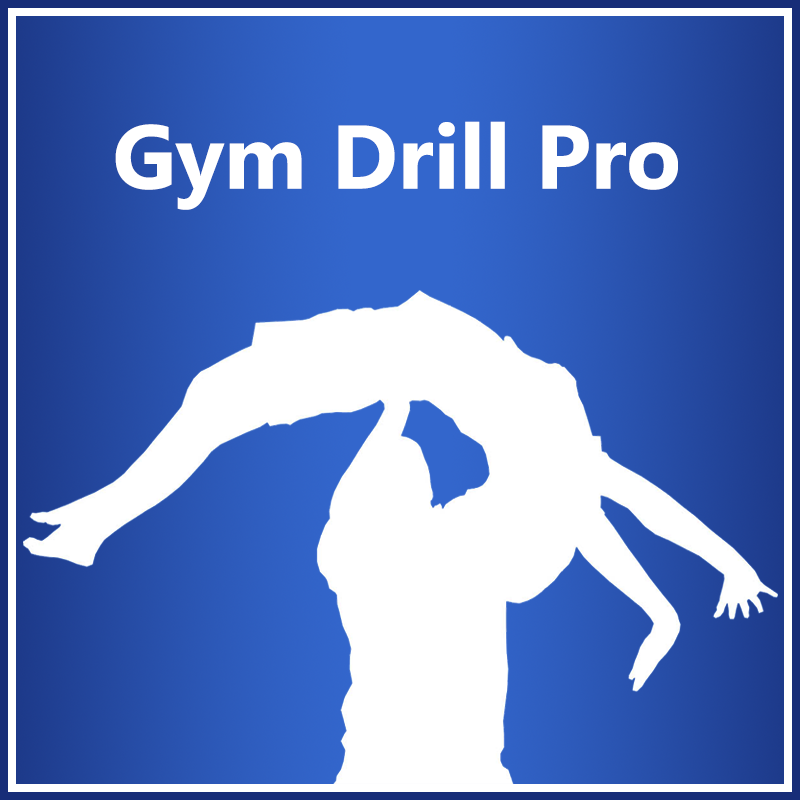

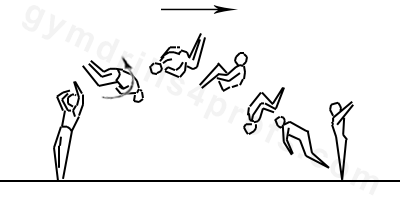
This skill starts from the snap down of the previous skill, usually a back handspring. There should be a strong drive, with an arch from the body and a turning motion from the leading hip. The body and the hips should be upright, before the vertical. If the body leans back from the hips in vertical and behind, the flipping part becomes long and low. The gymnast will not transform the horizontal speed into the height. That's why the hips at the moment of the bounce should be before the vertical position. The turned leading hip gives direction to the full twist. There are two ways of twisting in the flight, so-called “Tsukahara”. The first is to perform the full twist during the first flip (full-in-back-out). The other method is to have each flip contain a half twist (half-in-half-out). There is also another slightly less common way of performing the full twist. This method involves containing the entire twist to the second flip (back-in-full-out). In this case, the gymnast should not turn their leading hip during the bounce.
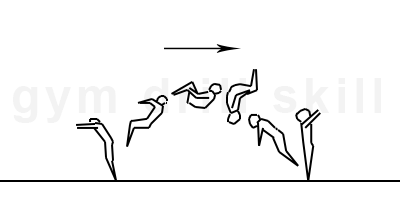
During the upward bounce, the arms should be raised aggressively above the shoulders with an open chest and shoulders. The hips should be extended, the body straight, with a slight arch. The gymnast should jump strong, pushing on the floor until he/she is on their tippy-toes. During the flight, the knees should lift and bend towards the belly, with a pike from the hips. The head should be in a neutral position. Raising the hips helps to accelerate the backward rotation. During the flip, the arms should be executing a back circle, the gymnast should then grab their legs. Prior to the landing (around horizontal), the body should open into a stretched position.
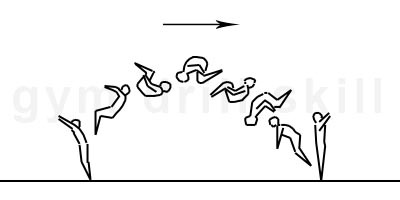
During the upward bounce, the arms should be raised aggressively above the shoulders with an open chest and shoulders. The hips should be extended, the body straight, with a slight arch. The gymnast should jump strong, pushing on the floor until he/she is on their tippy-toes. During the flight, the knees should lift and bend towards the belly, with a pike from the hips. Immediately after the bouncing, the athlete should grab their legs in tucked position.There are two ways of holding the legs. In the first method, the gymnast lowers the arms and catches at their knees. In this case, it’s faster, because the route of the hands is shorter. The downside is that lowering the arm in this way is a counter move. After catching the knees, the hands are pulling the knees in and up, in order to increase the speed. Another way of catching the legs is to have the arms grab the hamstrings after performing a backward circle. The route for the arms is longer, but they naturally follow the motion of the flip. This can easily accelerate the rotation speed. Prior to the landing (around horizontal), the body should open and the arms should raise in front of the chest.
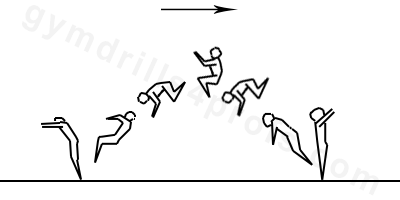
The gymnast should perform the double back without holding onto their legs. This technique is essential in order to be able to twist.
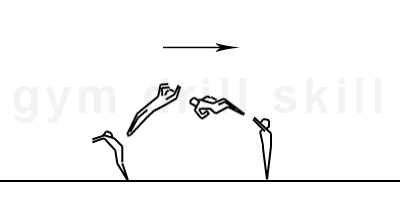
After the snapdown, the gymnast should raise their arms fast. The leading arm should be bent at the level of the head and the elbow behind the back. The supporting arm should be bent, over the shoulders. The body should be extended, slightly arched from the hips, and the hips should be slightly twisted, following the leading arm. The head should be in a neutral position. The gymnast leaves the floor at the vertical position, jumping from their toes. The twist starts from the leading side of the hip. For example: if the gymnast chooses to turn on their right side, then the leading hip is the left, and the gymnast should lean slightly on the right side. Upon reaching vertical, the body should be shortening, and after vertical (concluding the rotation), the gymnast should immediately extend in preparation for the landing. The head should be in a neutral position. At the landing, the arms should be bent in front of the chest.
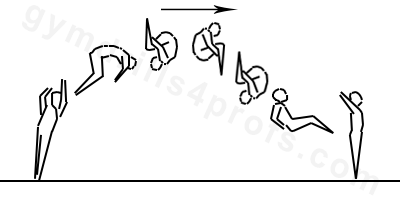
The gymnast should first improve their double Arabian off of a trampoline into a foam pit. Once they have done this, the next step is to perform it on a tumble track into the pit.
Improve the skill first on trampoline. Then move to on tumble track in the pit.
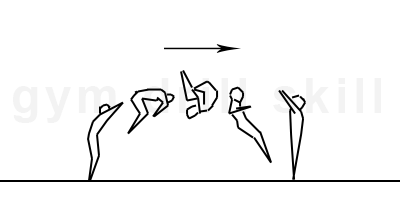
A front tuck flip is usually performed after a modest run. The last step of the run should be the hurdle. During the hurdle the arms should be doing a circle sideways, from downward to upward. The arms should finish over the shoulders. The head should be in a neutral position with the body extended, slightly arched, with the hips forward. The gymnast should jump from their toes, with their feet together. During the flight (until vertical), the gymnast should regroup their body. The legs should be bent and moving backward, at the same time the upper body and the arms should be following the legs. The gymnast may hold their legs, but this is optional. From the vertical position (at the highest point in the flip), the body should begin extending and preparing for the landing. The head should be in a neutral position. At the landing, the arms should be bent in front of the chest.
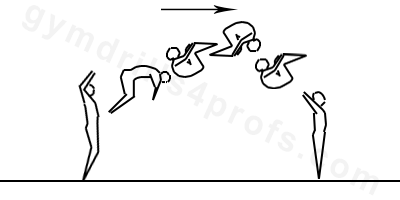
The gymnast should first practice their double front off of a trampoline into a foam pit. Once progress has been made they can move on to performing the skill off the end of the tumble track into a pit.
Improve the skill on the trampoline.
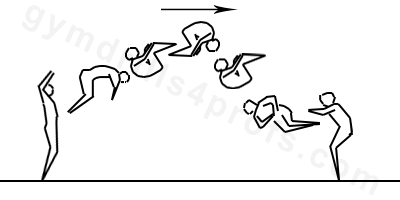
The gymnast should perform this skill on a trampoline into a foam pit, then move onto the tumble track into the foam pit. The gymnast should emphasize on having significant height, and twisting during the second flip.
Improve the skill on the trampoline.
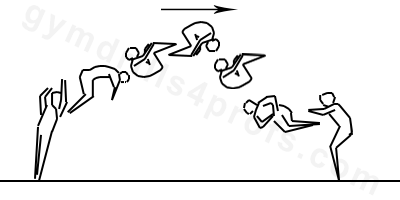
The gymnast should perform this skill on a trampoline into a foam pit, and then move on to performing it off the end of a tumble track into the foam pit.
Improve the skill first on the trampoline.
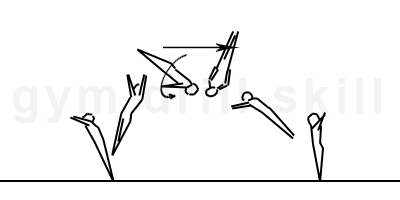
The correct execution of the full twist layout relies on a correct back layout. After the snapdown, the gymnast should raise their arms fast. The leading arm should be bent at the level of the head and the elbows behind the back. The supporting arm should be bent, over the shoulders. The body should be extended, slightly arched from the hips, and the hips should be slightly twisted, following the leading arm. The head should be in a neutral position. The gymnast leaves the floor at the vertical position, jumping from their toes. The twist starts from the leading side of the hip. For example: if the gymnast chooses to turn on their right side, then the leading hip is the left, and the gymnast should lean slightly on the right side. During the twist, the body should be straight and slightly in a hollow. At the last quarter of the flip, when the gymnast is around the horizontal, the full twist should already be concluded. The body is slightly arched and the arms should raise around the level of the chest in preparation for the landing. At the landing, the arms should be bent in front of the chest.
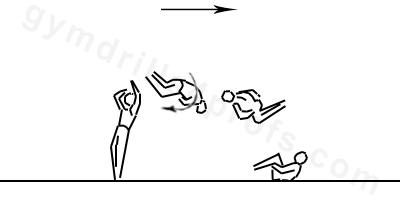
This drill can be done from standing, or at the end of the floor from a tumbling pass. The gymnast should perform a backward full twist, and land on their backs in the pit.
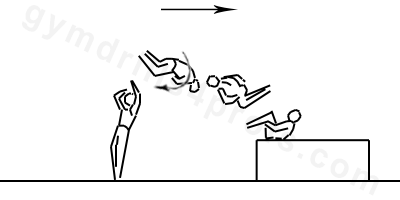
This drill can be done from standing, or from a tumbling pass. Once the gymnast has added enough height to their full, they can begin to practice landing on their backs on a resi mat. The height of the landing mat will motivate the gymnast to increase the height of the backward full twist as well.

The gymnast should first practice this skill off of a trampoline into a foam pit. They can then perform it off the end of a tumble track into the foam pit. When the gymnast becomes familiar with the skill, it can be performed from a tumbling pass off the end of the floor into a pit.
Improve the skill first on the trampoline.
Integral part of gymnastics coaching process are skill drills. They help gymnasts to learn easier and technically correct. With GYM DRILL PRO you will find variety of ideas for the most the basic gymnastics skills. There are plenty of images with skill drill progressions. It is intended to support explicitly the qualified coaches in their daily coaching business. DO NOT practice without the guidance of proper professionals.